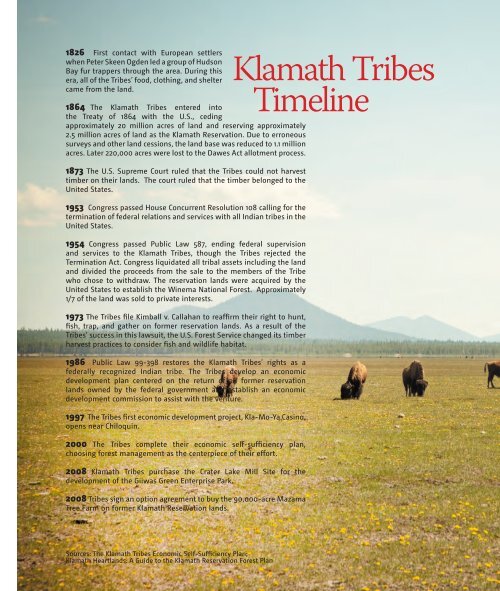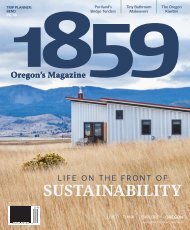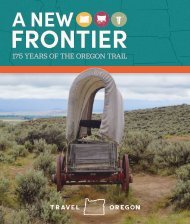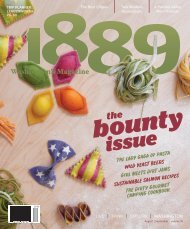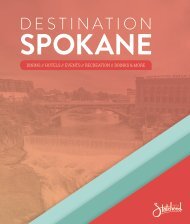1859 Summer 2009
1859 Summer 2009
1859 Summer 2009
Create successful ePaper yourself
Turn your PDF publications into a flip-book with our unique Google optimized e-Paper software.
1826 First contact with European settlers<br />
when Peter Skeen Ogden led a group of Hudson<br />
Bay fur trappers through the area. During this<br />
era, all of the Tribes’ food, clothing, and shelter<br />
came from the land.<br />
1864 The Klamath Tribes entered into<br />
the Treaty of 1864 with the U.S., ceding<br />
approximately 20 million acres of land and reserving approximately<br />
2.5 million acres of land as the Klamath Reservation. Due to erroneous<br />
surveys and other land cessions, the land base was reduced to 1.1 million<br />
acres. Later 220,000 acres were lost to the Dawes Act allotment process.<br />
1873 The U.S. Supreme Court ruled that the Tribes could not harvest<br />
timber on their lands. The court ruled that the timber belonged to the<br />
United States.<br />
1953 Congress passed House Concurrent Resolution 108 calling for the<br />
termination of federal relations and services with all Indian tribes in the<br />
United States.<br />
1954 Congress passed Public Law 587, ending federal supervision<br />
and services to the Klamath Tribes, though the Tribes rejected the<br />
Termination Act. Congress liquidated all tribal assets including the land<br />
and divided the proceeds from the sale to the members of the Tribe<br />
who chose to withdraw. The reservation lands were acquired by the<br />
United States to establish the Winema National Forest. Approximately<br />
1/7 of the land was sold to private interests.<br />
1973 The Tribes file Kimball v. Callahan to reaffirm their right to hunt,<br />
fish, trap, and gather on former reservation lands. As a result of the<br />
Tribes’ success in this lawsuit, the U.S. Forest Service changed its timber<br />
harvest practices to consider fish and wildlife habitat.<br />
1986 Public Law 99-398 restores the Klamath Tribes’ rights as a<br />
federally recognized Indian tribe. The Tribes develop an economic<br />
development plan centered on the return of all former reservation<br />
lands owned by the federal government and establish an economic<br />
development commission to assist with the venture.<br />
1997 The Tribes first economic development project, Kla-Mo-Ya Casino,<br />
opens near Chiloquin.<br />
2000 The Tribes complete their economic self-sufficiency plan,<br />
choosing forest management as the centerpiece of their effort.<br />
2008 Klamath Tribes purchase the Crater Lake Mill Site for the<br />
development of the Giiwas Green Enterprise Park.<br />
2008 Tribes sign an option agreement to buy the 90,000-acre Mazama<br />
Tree Farm on former Klamath Reservation lands.<br />
Klamath Tribes<br />
Timeline<br />
Sources: The Klamath Tribes Economic Self-Sufficiency Plan;<br />
Klamath Heartlands: A Guide to the Klamath Reservation Forest Plan


